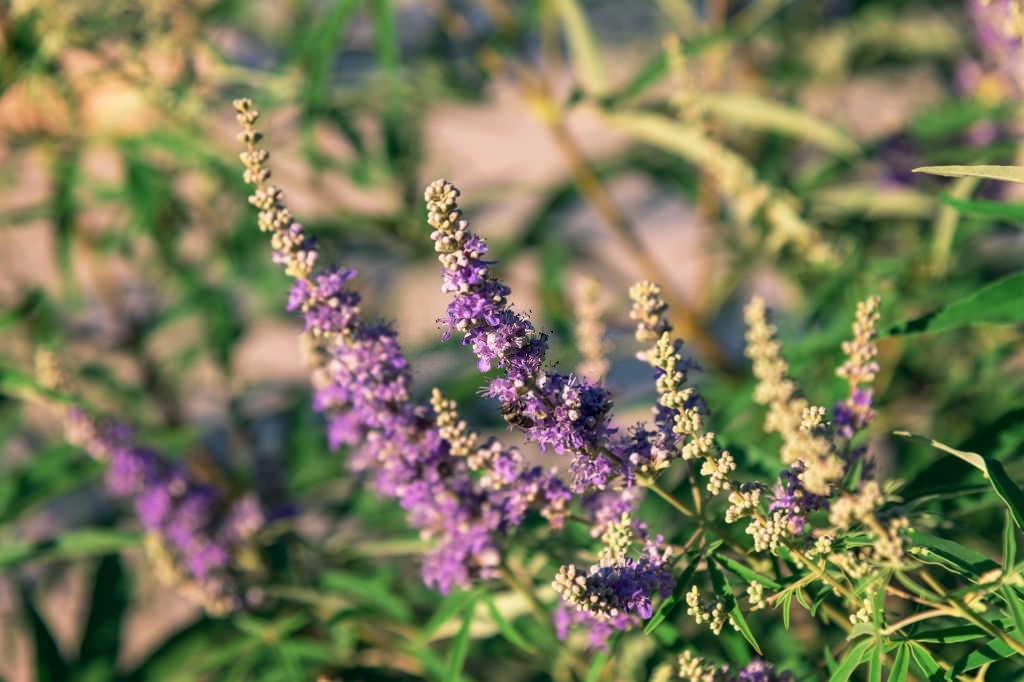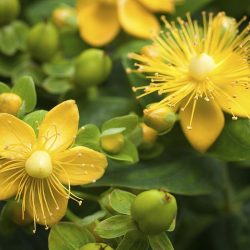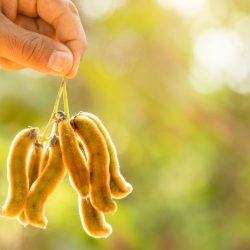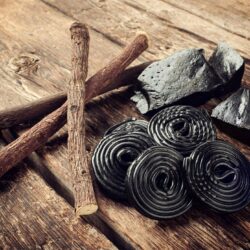Chaste tree, a medicinal plant revered since ancient times, is now attracting renewed interest for its remarkable therapeutic properties. Used by Hippocrates and Dioscorides for its curative virtues, chaste tree, or Vitex agnus-castus, offers a range of benefits from hormone regulation to anti-inflammatory applications. In this article, we delve into the fascinating world of chasteberry, exploring its history, botanical characteristics and modern perspectives on its use in herbal medicine. This age-old plant, which has stood the test of time, is proving to be a precious ally in the field of natural health, deserving special attention in our quest for natural well-being.
What is Chasteberry?
The pepper tree, or chaste tree (Vitex agnus-castus), belongs to the Verbenaceae or Lamiaceae family, according to various classifications. It has compound-palmate foliage and spikes of small, purplish flowers. This hardy, robust shrub can grow to between 1.5 and 2 metres tall, with older specimens reaching up to 10 metres. Its blue flowers appear in August-September, and the shrub is a honey producer.
In terms of cultivation, the chaste tree thrives even in poor, well-drained soil and is drought-resistant. It can be propagated by cutting or sowing in a cold frame. There are two main varieties: Vitex agnus castus alba, with white flowers, and Vitex agnus castus rosea, with pink flowers.
The oval, brownish-black fruit of the chaste tree is remarkable for its peppery flavour. Its composition includes terpenes, phenolic compounds and fatty oils, with a minimum concentration of 0.08% casticine. The plant has been studied using various chromatographic and spectroscopic methods.
Chasteberry is included in the list of plants traditionally used, and has a monograph in the European Pharmacopoeia for its whole, ripe, dried fruit. It is used for its varied medicinal properties, reflecting its rich chemical composition.
A little history
Chasteberry, associated with the goddess Hera, symbolised fertility and purity in ancient Greece. Hera, who represented legitimate marriage and the protection of women in childbirth, emphasised the importance of the chaste tree. During the Thesmophoria, young girls adorned themselves with its flowers to preserve their purity and virginity.
Athenian women also used it to remain chaste during these celebrations, which were marked by continence and ritual fasting. More specifically, the priestesses of Demeter adopted this practice, not to promote infertility, but as a preparation for fertility, symbolically warding off men thanks to the chasteberry’s anaphrodisiac properties.
Dioscorides called this plant agnos (chaste in Greek), but a confusion between agnos and agnus (lamb in Latin) gave rise to the vernacular name of lamb-chaste, albeit comical and unrelated. Agnus-castus reflects the plant’s anaphrodisiac power. The term vitex, derived from the Greek vieo (to plait), refers to the suppleness of its twigs, used in basketry and to create ties.
Chaste tree’s reputation as an anaphrodisiac in humans persists. In the Middle Ages, it was nicknamed pepper herb and monk’s pepper. As hot substances such as rocket and pepper were banned in monasteries, chasteberry fruit, with its spicy, peppery flavour, became a substitute, helping monks to maintain carnal chastity. Grown in medieval cloisters, monks made belts from them to protect themselves from Venus‘ desire. This practice endured and was still used in the 19th century.
What are the main pharmacological properties of Chaste Tree berries?
Chasteberry berries contain several compounds. These include diterpenic substances such as rotundifuran, iridoids (agnuside) and flavonoids (casticine). There are also alkaloids, steroids and essences. Diterpenes act on the pituitary gland. They stimulate the receptors for dopamine, a neurotransmitter in the brain.
This action reduces the production of prolactin by the pituitary gland. It also increases the progesterone produced by the ovaries. These effects help to regulate menstrual cycles. Insufficient progesterone can cause female sterility, and chasteberry has been studied for this indication.
Inhibition of prolactin secretion
Chasteberry inhibits prolactin secretion by pituitary cells in vitro. This property, confirmed in vivo, is linked to the dopaminergic agonist activity of certain deterpenes such as rotundifuran and clerodienols.
Clinically, the reduction in prolactin secretion leads to a prolongation of prolactin secretion leads to a prolongation of the lifespan of the corpus luteum and therefore regulation of the length of cycles. This action has been demonstrated in particular in women with latent hyperprolactinaemia: chasteberry re-establishes a normal luteal phase. Another consequence of reduced prolactin secretion is a reduction in mastodynia.
A double-blind, placebo-controlled study tested a chaste tree extract on 97 women, aged 35 on average, suffering from premenstrual mastodynia. Carried out over 3 cycles, the study revealed a significant reduction in pain from 1 to 2 cycles of treatment, stabilising after the third.
Chaste tree fruit extract acts in a dopaminergic way. It acts as a direct central agonist, specifically on the D2 dopamine receptor in the mesolimbic and extrapyramidal systems. It also acts indirectly at peripheral level, inhibiting prolactin secretion.
The diterpenes in chasteberry (rotundifuran) act in strong structural analogy with steroids. By stimulating D2 receptors, clerodiadienols exert an anti-prolactin activity almost identical to that of dopamine.
Overall improvement in the hormonal cycle and reduction in premenstrual syndrome symptoms
Chasteberry acts as an agonist of μ-opioid receptors. It mimics the action of β-endorphin, normalising pulsatile secretion of GnRh, the hypothalamic hormone which controls secretion of the pituitary gonadotropins LH and FSH. In effect, it modulates the pulsatile release of these gonadotropins (anti-FSH action).
In addition to its prolactin-suppressing and central dopaminergic actions, which explain the activity of chasteberry on the psychological, motor and somatic aspects of premenstrual syndrome, the plant is anti-oestrogenic and causes progesterone concentrations to rise again in the middle of the cycle.
In fact, Chasteberry limits the appearance of symptoms linked to premenstrual syndrome (mastodynia, mood disorders, irritability, breast tension, fluid retention, migraines, etc.). In this context, it has a sedative and anxiolytic effect.
Chaste tree is an emmenagogue; it regulates the female cycle by stimulating and facilitating menstrual blood flow in the pelvic region and uterus. It corrects menstrual cycle abnormalities associated with luteal insufficiency and latent hyperprolactinaemia.
Numerous clinical studies have demonstrated the efficacy of chasteberry in the treatment of premenstrual syndrome, in particular a double-blind, placebo-controlled study involving 1,170 women, aged 36 on average. The study was conducted over 3 cycles, at the end of which patients receiving the extract noted a significant improvement in their condition, taking all symptoms into account. Chaste tree is also said to improve menopausal climacteric disorders, and its use in this indication spread throughout the 20th century.
Anti-cancer
Chaste tree inhibits the proliferation of HL-60 myeloid leukaemia cells and promotes apoptosis(rotundifuran, polymethoxyflavones, luteolin).
A recent in vitro study revealed that an alcoholic extract of chasteberry can destroy cancer cells, particularly breast carcinomas, by apoptosis (self-destruction). This extract is also active against tumour cells of the uterus and ovaries. The potential use of chasteberry in the treatment of cancer is expanding with each new study, offering hope.
Chasteberry has been shown to inhibit the proliferation of HL-60 myeloid leukaemia cells and to promote their apoptosis. This is due to compounds such as rotundifuran, polymethoxyflavones and luteolin. A 2019 in vitro study specifically demonstrated that casticin from Vitex species inhibits proliferation and induces mitochondria-dependent apoptosis in oesophageal cancer cells.
Are there any precautions for using Chaste tree?
How should Chaste tree be taken and at what dosage?
Chaste tree products are often standardised to ensure a constant concentration of active ingredients. According to the European Medicines Agency, the recommended daily dosage is equivalent to 28 to 52 mg of dried berries.
Chasteberry acts on the hormonal system and can mask serious health problems. This includes diseases such as pituitary cancer. It should therefore only be used under medical supervision. What’s more, the effects of chasteberry take time to become apparent. Treatment often lasts several weeks. The duration varies according to the indications, ranging from three to six menstrual cycles or more. It is therefore advisable to avoid self-medication with chasteberry.
- As a dietary supplement, in the form of dry or standardised extract, or powder in capsules.
- Standardised fresh plant fluid extract: 5 to 10 ml per dose in water.
- Hydroalcoholic fluid extract: 20 to 30 drops per dose in water.
In mastodynia, the dosage may be increased as required, the effect being clearly dose-dependent.
It’s important to consider the reason you’re taking chasteberry – whether it’s to relieve the symptoms of premenstrual syndrome, hormonal acne, the menopause or infertility. In general, recommended doses may vary depending on the condition you are trying to treat. It is also important to take into account your age, weight and general state of health. It’s important to consult your doctor or healthcare professional before taking any chasteberry-based supplements.
What do the health authorities think?
Clinical studies of high methodological quality have explored the efficacy of chasteberry. They show beneficial effects on the symptoms of premenstrual syndrome, breast pain during the menstrual cycle and irregular periods caused by low progesterone secretion.
Although studies on female sterility linked to insufficient progesterone secretion are promising, it is premature to draw any definitive conclusions. Other uses for chasteberry remain to be demonstrated.
Concerning the opinions of health authorities:
- The EMA (European Medicines Agency) considers the use of chasteberry to alleviate minor premenstrual syndrome disorders to be traditional, recommending that it should not be used for more than three consecutive cycles.
- Commission E of the German Ministry of Health recognises its use for irregular periods, premenstrual syndrome and cycle-related breast pain, under medical supervision.
- ESCOP (European Scientific Coordination on Phytotherapy) recognises its use to relieve premenstrual syndrome, breast pain and to manage irregular or absent periods. Unlike the EMA, it suggests a course of treatment lasting more than three months to fully experience its positive effects.
Chaste tree as a magistral preparation of standardised extracts in liquid form (EPS)
If you are considering taking chasteberry for its curative properties, you may be interested in magistral preparations. SPEs are plant extracts that have been prepared in such a way as to ensure a uniform concentration of active ingredients. In this section, we will explore the use of chasteberry in magistral preparations of standardised extracts in liquid form and the advantages this can offer over other forms of chasteberry.
- In combination with alchemilla: In premenstrual syndrome with metrorrhagia, to be taken from the 14th day of the cycle (possibly as early as the 10th day, in the case of hormonal disorders starting at ovulation) until the 1st day of menstruation.
- In association with nettle root 1/3 for 2/3 chaste tree: For fibroids, hyperplasia of the uterine mucosa, benign prostatic hypertrophy and gynaecomastia. Particularly in adolescents and men over 50.
- In association with artichoke: Against hyperprolactinaemia, hyperoestrogenism, to be taken in the 2nd part of the cycle or continuously. Lactation withdrawal.
- In association with mucuna (2/3 for 1/3 chaste tree ): To combat Parkinson’s disease, restless legs syndrome and mood disorders linked to a drop in dopamine.
Medical literature and clinical trials
- Atmaca M. et al, Fluoxetine versus Vitex agnus castus extract in the treatment of premenstrual dysphoric disorder, Hum Psychopharmacol, 2003
- Milewizcz A. et al, Vitex agnus castus extract in the treatment of luteal phase defects due to latent hyperprolactinemia. Results of a randomized placebo-vontrolled double-blind study, Arzneimittelforschung, 1993
- Schellenberg R., Treatment for the premenstrual syndrome with agnus castus fruit extract: prospective, randomised, placebo controlled study, BMJ, 2001
- Wuttke W. et al, Chaste tree (Vitex agnus-castus) – pharmacology and clinical indications, Phytomedicine, 2003
- Hoberg E. et al, Diterpenods from the fruits of Vitex agnus-castus, Phytochemistry, 1999
- Seidl M.M. et al, Alternative treatments for menopausal sumptoms. Systematic review of scientific and lay literature, Can Fam Physician, 1998
- Ko W.G. et al. Effects of luteolin on the inhibition of proliferation and induction of apoptosis in human myeloid leukamia cells; Phytother Res. 2002
- Van Die M.D. et al, Hypericum perforatum with Vitex agnus-castus in menopausal symptoms: a randomized, controlled trial, Menopause, 2009





